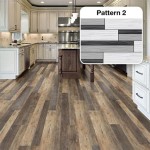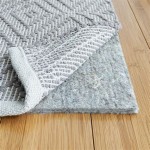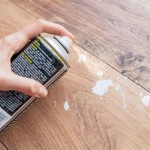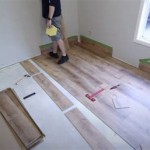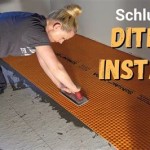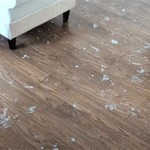How to Get Super Glue Off of Laminate Floor
Accidents happen, and one common household mishap involves super glue finding its way onto unintended surfaces, such as laminate flooring. Super glue, known for its strong and rapid bonding properties, can be particularly challenging to remove from laminate without causing damage. This article provides a comprehensive guide on safely and effectively removing super glue from laminate floors, outlining various methods and precautions to minimize potential harm.
Laminate flooring, while durable and aesthetically pleasing, has a surface that can be susceptible to scratches, discoloration, and delamination if harsh chemicals or abrasive techniques are employed. Therefore, a delicate and methodical approach is crucial. The success of super glue removal often depends on the type of glue, the duration it has been on the floor, and the specific type of laminate flooring.
Understanding Laminate Flooring and Super Glue
Before attempting any removal method, it is essential to understand the characteristics of laminate flooring and the adhesive properties of super glue. Laminate flooring consists of several layers, including a core layer typically made of high-density fiberboard (HDF) or medium-density fiberboard (MDF), a decorative layer that provides the visual appearance of wood, stone, or tile, and a protective wear layer that resists scratches and stains. This wear layer is critical as it is the surface being treated during the removal process.
Super glue, also known as cyanoacrylate adhesive, is a fast-acting, high-strength adhesive that forms a strong bond between surfaces. It hardens rapidly upon exposure to moisture in the air, creating a rigid and often brittle structure. This rapid hardening and strong bonding capability make it difficult to remove without potentially damaging the underlying surface. Super glue's chemical composition also means it can react with certain materials, potentially causing discoloration or damage to the laminate's finish.
Methods for Removing Super Glue from Laminate Floor
Several methods can be employed to remove super glue from laminate flooring, each with varying degrees of effectiveness and potential risk. It is always recommended to test any method in an inconspicuous area first to ensure it does not damage or discolor the laminate. Consider factors such as the age of the glue stain, the type of laminate, and the available tools before selecting a method.
1. The Soapy Water and Soft Cloth Method: This is the gentlest approach and should be the first line of defense. Warm water and mild dish soap can sometimes soften the super glue, making it easier to remove. Mix a small amount of dish soap in warm water. Dampen a soft cloth with the soapy water and gently rub the affected area. Avoid using excessive water, as it can seep into the seams of the laminate and cause damage. Continue rubbing gently for several minutes, checking periodically to see if the glue is softening. If the glue begins to soften, carefully scrape it away with a plastic scraper or a credit card. After removing the glue, clean the area with a damp cloth and dry it thoroughly.
This method is most effective on fresh super glue spills or small amounts of dried glue. It relies on softening the glue rather than dissolving it, reducing the risk of damage to the laminate's surface.
2. Using Acetone or Nail Polish Remover: Acetone is a powerful solvent that can dissolve super glue. However, it can also damage laminate flooring, so it must be used with extreme caution. Ensure adequate ventilation during use. Before applying acetone to the glue spot, protect the surrounding laminate by covering it with painter's tape or a similar protective material. Soak a cotton ball or swab with acetone. Gently dab the acetone onto the super glue, avoiding contact with the surrounding laminate. Let the acetone sit for a short period (no more than a minute or two) to soften the glue. Use a plastic scraper or a credit card to carefully lift the softened glue from the laminate. Repeat the process as needed, being careful not to over-saturate the area with acetone. Once the glue is removed, immediately wipe the area with a damp cloth to remove any residual acetone. Dry the area thoroughly.
It is crucial to perform a spot test in an inconspicuous area before using acetone. Watch for any signs of discoloration or damage to the laminate's finish. If damage occurs, discontinue use and consider alternative methods. Acetone should only be used if the soapy water method proves ineffective.
3. Applying Heat with a Hair Dryer: Heat can soften super glue, making it easier to scrape away. A hair dryer provides a controlled source of heat that is less likely to damage the laminate than other heat sources. Set the hair dryer to a low or medium heat setting. Hold the hair dryer a few inches away from the super glue spot. Direct the heat onto the glue for several minutes, being careful not to overheat the laminate. Check the glue periodically to see if it is softening. Once the glue is softened, use a plastic scraper or a credit card to carefully lift it from the laminate. Avoid using metal scrapers, as they can scratch the surface. After removing the glue, clean the area with a damp cloth and dry it thoroughly.
This method works best on larger areas of super glue or glue that has hardened considerably. It is important to monitor the laminate closely to prevent overheating. If the laminate becomes too hot, stop applying heat and allow it to cool before continuing.
4. Utilizing Isopropyl Alcohol (Rubbing Alcohol): Isopropyl alcohol, while not as strong as acetone, can still be effective in dissolving super glue. It is also less likely to damage laminate flooring than acetone. Apply isopropyl alcohol directly to the super glue spot. Let it sit for several minutes to soften the glue. Use a plastic scraper or a credit card to carefully lift the softened glue from the laminate. Repeat the process as needed. After removing the glue, clean the area with a damp cloth and dry it thoroughly.
Isopropyl alcohol is a good alternative to acetone for those concerned about potential damage to their laminate flooring. While it may take longer to dissolve the glue, it is a safer option overall. Choose a high concentration of isopropyl alcohol (70% or higher) for optimal results.
5. Vegetable Oil or Cooking Oil: Oils can help to loosen the bond between the super glue and the laminate floor. Apply a generous amount of vegetable oil or cooking oil to the super glue spot. Let it sit for several hours or even overnight to allow the oil to penetrate the glue. Use a plastic scraper or a credit card to carefully lift the softened glue from the laminate. Clean the area thoroughly with dish soap and water to remove any residual oil. Dry the area completely.
This method is gentle and less likely to cause damage to laminate flooring, making it a suitable option for delicate surfaces. However, it may require a longer soaking time to be effective.
6. Using a Specialized Adhesive Remover: Several commercially available adhesive removers are specifically designed to remove super glue and other types of adhesives. These products often contain a blend of solvents and chemicals that are effective in breaking down the glue's bond. It is crucial to select an adhesive remover that is safe for use on laminate flooring. Before applying the adhesive remover, read the product label carefully and follow the manufacturer's instructions. Perform a spot test in an inconspicuous area to ensure the remover does not damage or discolor the laminate. Apply the adhesive remover to the super glue spot. Let it sit for the recommended amount of time. Use a plastic scraper or a credit card to carefully lift the softened glue from the laminate. Clean the area thoroughly with a damp cloth and dry it completely.
While specialized adhesive removers can be effective, it is essential to choose the right product and use it according to the instructions. Some removers may contain harsh chemicals that can damage laminate flooring, so caution should be exercised.
Safety Precautions During Super Glue Removal
When working with solvents or adhesives, it is essential to take necessary safety precautions to protect oneself and prevent further damage to the laminate flooring.
Ventilation: Ensure adequate ventilation when using solvents such as acetone or isopropyl alcohol. Open windows and doors to allow fresh air to circulate. Avoid breathing in the fumes, as they can be harmful.
Protective Gear: Wear gloves to protect skin from contact with solvents and adhesives. Eye protection, such as goggles or glasses, should be worn to prevent splashes from entering the eyes.
Flammability: Be aware that many solvents, including acetone and isopropyl alcohol, are flammable. Keep them away from heat sources, sparks, and open flames.
Spot Testing: Always perform a spot test in an inconspicuous area before applying any solvent or adhesive remover to the entire glue spot. This will help determine if the product will damage or discolor the laminate flooring.
Gentle Techniques: Use gentle techniques and avoid excessive force when scraping or rubbing the glue. This will minimize the risk of scratching or damaging the laminate's surface.
Clean Up: After removing the glue, clean the area thoroughly with a damp cloth and dry it completely. This will remove any residual solvents or adhesives and prevent further damage to the laminate.
Preventing Future Super Glue Spills
Prevention is always better than cure. Taking steps to prevent super glue spills can save time and effort in the long run.
Designated Workspace: Use super glue in a designated workspace that is covered with a protective material, such as a drop cloth or newspaper. This will prevent glue from accidentally spilling onto the laminate flooring.
Controlled Application: Apply super glue carefully and in small amounts. Avoid squeezing the bottle too hard, as this can cause the glue to squirt out uncontrollably.
Proper Storage: Store super glue in a safe place away from children and pets. Ensure the bottle is tightly closed to prevent leaks and spills.
Alternative Adhesives: Consider using alternative adhesives for projects where super glue is not strictly necessary. Many other types of adhesives are available that are less likely to cause permanent damage if spilled.
When to Seek Professional Help
In some cases, super glue removal may be too challenging or risky to attempt on one's own. If the glue spot is large, deeply ingrained, or located in a highly visible area, it may be best to seek professional help. Professional floor cleaning or repair services have the expertise and tools necessary to remove super glue without damaging the laminate flooring.
Additionally, if the laminate flooring has already been damaged by previous attempts to remove the glue, a professional may be able to repair or replace the damaged section. Professional intervention can prevent further complications and ensure the flooring is restored to its original condition.

How To Remove Super Glue From Laminate Flooring 14 Steps

How To Remove Super Glue From Laminate Flooring 14 Steps

How To Remove Super Glue From Laminate Flooring 14 Steps

How To Remove Super Glue From Laminate Flooring 14 Steps

How To Remove Super Glue From Laminate Flooring 14 Steps

How To Remove Super Glue From Laminate Flooring 14 Steps

How To Remove Super Glue From Laminate Flooring 14 Steps

Don T Panic If You Spill Super Glue On Wood Floors Here S A Simple Solution

Housekeeping Tips How To Get Glue Off Of Hardwood Floors

Remove Super Glue From Hardwood Flooring
See Also
